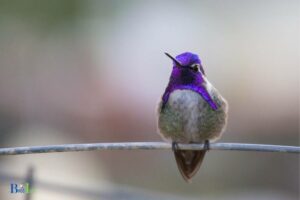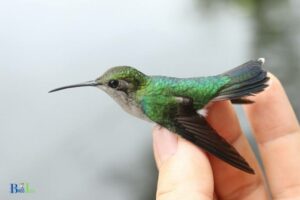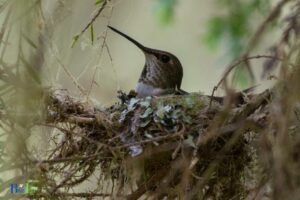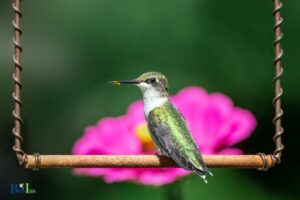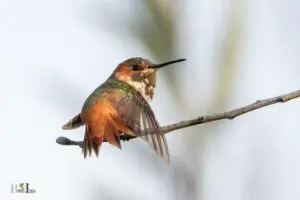How to Identify a Black Chinned Hummingbird: A Guide!
To identify a black-chinned hummingbird, look for its distinctive features such as the iridescent purple band on the male’s throat, its green back, and the white spot behind the eye.
The black-chinned hummingbird is a small bird species that can be identified by its particular coloration and physical characteristics.
Males have a glossy, purple band on their throat, which appears black under certain lighting conditions, hence the name.
They also have a green back and a white spot behind their eyes. Females have a more subtle appearance, with a grayish-white throat and belly, and a faint, dusky stripe behind the eye.
Black-chinned hummingbirds are known for their agility and high-speed hovering capabilities.
These tiny birds can be seen in a variety of habitats, such as open woodlands, deserts, and gardens.
They feed on nectar from flowers and insects, as well as sugar water from feeders.
Listen for their distinct vocalizations, which include rapid, high-pitched chatter and a metallic, buzzing sound during their courtship displays.
11 Features for Identifying Black Chinned Hummingbirds
| Feature | Description |
| Size | 3.5 – 4 inches (8.9 – 10.16 cm) in length |
| Weight | 0.1 – 0.2 ounces (2.8 – 5.7 grams) |
| Bill | Straight and short, with the upper part slightly curved downward |
| Throat Color | Male: Iridescent black-chin and throat, Female: White throat with black spots |
| Plumage | Male: Metallic green upperparts and white underparts, Female: Green upperparts and pale gray underparts |
| Tail | Male: Forked tail with iridescent black feathers, Female: Rounded tail with white tips on outer feathers |
| Wing Shape | Pointed, slightly curved wings with rapid wing beats |
| Habitat | Deserts, canyons, mountain forests, and woodland edges |
| Range | Western United States and Northern Mexico |
| Flight Pattern | Unique J-shaped diving pattern during courtship displays |
| Vocalizations | High-pitched, buzzy metallic-sounding zee-zee-zee-zee |
Key Takeaway
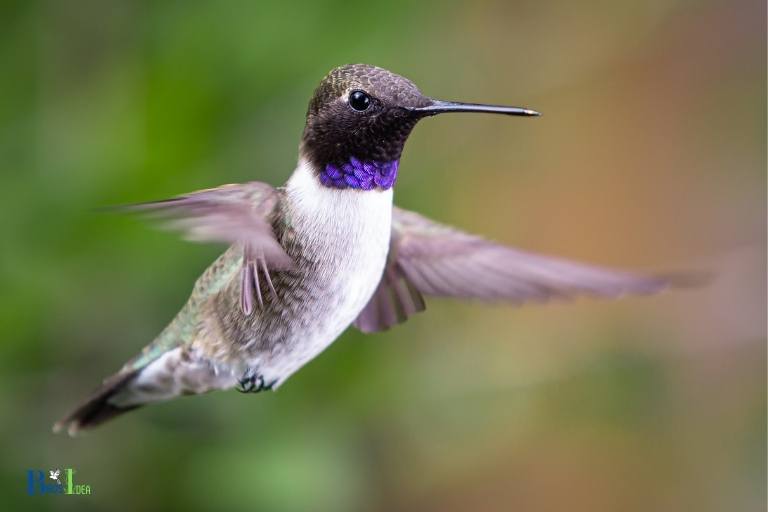
Five Facts About: Black Chinned Hummingbirds
Why Is It Important To Identify A Black Chinned Hummingbird
Hummingbirds are remarkable creatures, known for their agility and their striking appearance. One of the most fascinating hummingbirds is the black chinned hummingbird. Identifying this bird species is not only fascinating but also beneficial.
Here are some key benefits of identifying a black chinned hummingbird:
Benefits Of Identifying The Bird
- Increased awareness of bird diversity: Hummingbirds come in different species, shapes, and sizes. Identifying the black chinned hummingbird is an opportunity to learn more about these intriguing creatures and the diversity of birdlife in general.
- Personal satisfaction: Identifying the black chinned hummingbird can be fulfilling, especially for bird enthusiasts, birdwatchers, and nature lovers. It’s a chance to add a new species and knowledge to your bird-watching list.
- Conservation: Identifying the black chinned hummingbird can contribute to conservation efforts. Knowledge of the bird’s distribution and habitats can help scientists and conservationists make informed decisions about protecting this charming species.
- Scientific research: Identifying the black chinned hummingbird can facilitate scientific research on the bird. Scientists can study the behavior, ecology, and populations of this bird and add new knowledge to the field of ornithology.
Identifying the black chinned hummingbird is not only fascinating but also beneficial for conservation, research, and personal satisfaction.
With this bird’s striking appearance and elusive nature, identifying it can be a rewarding experience for bird lovers and nature enthusiasts.
Size And Shape
Smaller In Size Compared To Other Hummingbirds
Black-chinned hummingbirds are a small type of bird commonly found throughout western north america. They are often much smaller in size than other types of hummingbirds.
Here are some key points to help you identify this species by its size:
- Male black-chinned hummingbirds are typically around 3.5 inches long from beak to tail, while females are slightly larger at around 3.75 inches.
- In flight, their wingspan is roughly 4.5 inches.
- Compared to other hummingbirds, black-chinned hummingbirds have a slimmer and more streamlined body shape.
- Their small size and distinctive shape make them easy to spot, even from a distance.
Unique Wing Shape
One of the most distinguishing characteristics of black-chinned hummingbirds is their unique wing shape.
Here are some key points to help you identify this species by its wings:
- Black-chinned hummingbirds have long, narrow wings with a slight curve that helps them produce a distinctive buzzing sound in flight.
- The tips of their wings are pointed and have a noticeable “hooked” shape.
- When at rest, their wings fold back against their bodies, often with a pointed angle at the elbow joint.
- The dark coloration on the undersides of their wings is another identifying feature.
By paying attention to these key features, you can learn to easily identify black-chinned hummingbirds wherever they may be. Happy bird watching!
Coloration
Description Of The Bird’S Green Feathering
The black chinned hummingbird is a small bird with a distinctive green plumage.
Here are some key points to help identify the bird’s green feathering:
- The male black chinned hummingbirds have iridescent green throat and crown feathers.
- The female black chinned hummingbirds have a more subdued green color on their back and head.
- The color tone of green can vary depending on the lighting conditions, angle, and age of the bird.
Identification Of The Black Throat Stripe
The identification of the black throat stripe is a crucial aspect to help distinguish the black chinned hummingbird from other hummingbird species.
Here are some key points:
- The male black chinned hummingbird has a black stripe on its throat that is sometimes hard to see, especially in poor lighting conditions.
- The black stripe represents a thin line of feathers that extends down from the lower throat center.
- Female black chinned hummingbirds do not have a black throat stripe, making them easier to identify.
Remember, the combination of the green plumage and throat stripe helps identify the bird as a black chinned hummingbird. By understanding the coloration of the feathers and the throat stripe, bird watchers can identify and appreciate this beautiful bird in the wild.
Feeding Behavior
Black chinned hummingbirds are amazing creatures with their shiny green feathers and iridescent violet throats.
They are found throughout the western and southwestern united states and mexico and are known for their fascinating feeding behavior.
Here’s what you need to know to identify a black chinned hummingbird and understand their feeding habits.
Description Of What The Bird Eats
Black chinned hummingbirds are primarily nectar feeders, but they also consume small insects and spiders, especially during nesting season.
Their diet consists of the following:
- Nectar: These tiny birds feed on the nectar of a variety of flowers, such as penstemons, salvias, and hummingbird feeders filled with a sugar-water solution.
- Insects and spiders: Black chinned hummingbirds consume small insects and spiders, including gnats, flies, mosquitoes, aphids, and spiders.
Identification Of Feeding Habits
Black chinned hummingbirds have unique feeding habits that distinguish them from other hummingbird species.
Here are some key points to note:
- Territory: Male black chinned hummingbirds aggressively defend their territory, which includes a food source. They will chase other males away from their feeding areas and will occasionally chase females that come too close.
- Hovering: These birds hover in the air while feeding at flowers and hummingbird feeders. They use their long, thin beaks to probe deep into the flower, lapping up nectar with their tongues up to 13 times a second.
- Energy conservation: Black chinned hummingbirds have developed an energy-conserving feeding technique called torpor. They slow down their metabolism at night and conserve energy while sleeping.
Black chinned hummingbirds are primarily nectar feeders but also consume small insects and spiders. Their feeding habits are unique, including territorial defense, hovering, and energy conservation.
Keep these key points in mind when attempting to identify a black chinned hummingbird in the wild.
Flight Patterns
Black chinned hummingbirds are fascinating creatures, known for their glossy purplish-black throat, bright green back, and off-white underparts.
While it can be challenging to identify different hummingbird species, their unique flight patterns can serve as a useful guide.
In this section, we will discuss the description of the black-chinned hummingbird’s unique flight pattern and how to identify the hovering behavior.
Description Of The Unique Flight Pattern Of The Bird
Black chinned hummingbirds have a distinctive flight pattern that differs from other hummingbird species.
Here are the key points:
- They fly in a straight line path with their wings beating several times per second.
- They move side to side or up and down in a hovering position that can last for several seconds.
- They produce a distinct trilling or high-pitched chirping sound while flying.
Identification Of Hovering Behavior
Hovering is a common behavior shown by hummingbirds worldwide, but black-chinned hummingbirds use this technique more frequently.
The following points describe how to identify the hovering behavior of black-chinned hummingbirds:
- Their body stays stationary in the air while their wings beat in a figure-eight motion.
- They can hover mid-air by rapidly flapping their wings, almost invisible to the human eye.
- When hovering, their tail feathers spread open and remain stationary.
Understanding the unique flight patterns and hovering behavior of black chinned hummingbirds is crucial to identifying them from other hummingbird species.
Now that you know the essential characteristics of their flight patterns, you will undoubtedly have an easier time spotting and identifying them in the wild.
Breeding Range
Black chinned hummingbirds are fascinating creatures to spot due to their unique appearance and characteristics. If you’re interested in identifying one, it is crucial to know where they nest.
This blog post will discuss the breeding range of the black chinned hummingbird, including an explanation of breeding locations and the bird’s preferred areas.
Explanation Of Breeding Locations
Breeding locations vary across the black chinned hummingbird’s range.
Here are a few key points to help you identify where they typically nest:
- Black chinned hummingbirds breed in the western half of north america, ranging from western texas and oklahoma to the pacific coast.
- They prefer nesting in open woodlands, riparian areas, and gardens along streams and rivers, but are also found in more arid and open habitats, such as deserts.
- Their nests are usually located on horizontal branches, commonly 10-20 feet above ground level. The female is solely responsible for building the nest and may choose to build several in a season.
Identification Of The Bird’S Preferred Areas
To spot a black chinned hummingbird, it’s essential to understand their preferred areas for breeding.
Here are some points to consider:
- Black chinned hummingbirds enjoy open woodlands with flowering trees and shrubs, particularly near water sources. They tend to avoid dense forests.
- They often nest in humans’ urban spaces, such as gardens and parks.
- Use binoculars to look for the hummingbird’s characteristic features, including its black and white plumage, metallic green back, and iridescent purple throat patch.
Overall, understanding the breeding range of the black chinned hummingbird can help with identification efforts. Keep in mind the locations of nesting sites and preferred habitats, and seek out those areas when looking for them.
Get ready to spot these fascinating and beautiful birds in your area!
Migration
Have you ever spotted a black chinned hummingbird during migration season and wondered about its behavior? These tiny birds are known for their vibrant colors and lightning-fast movements, but their migration pattern is equally fascinating.
In this section, we’ll look into the description of migration behavior and the identification of the range of the bird outside of breeding season.
Description Of Migration Behavior
Black chinned hummingbirds are neotropical migrants, which means they travel to different regions during different times of the year. Their migration cycle is usually between may and october.
These birds fly from the breeding grounds in the western regions of the united states and canada, to their winter homes in central mexico.
- The black chinned hummingbirds travel in large numbers to reach their destination in central mexico.
- These birds fly at a high altitude, usually at 15,000 feet, because it helps them conserve energy during their long journeys.
- During migration, these birds prefer to rest overnight and feed in areas that have an abundance of food sources, such as nectar-rich flowers.
Identification Of The Range Of The Bird Outside Of Breeding Season
Black chinned hummingbirds are usually found in breeding season in the western regions of north america, from southern canada to northern mexico.
However, during migration season, these birds can be spotted in several different locations across the united states.
- During migration, black chinned hummingbirds can be found in states like arizona, new mexico, texas, and colorado.
- These birds can also be spotted in the central region of mexico, where they spend their winter season.
- During migration, these birds usually stay in areas with an abundance of flowering plants and feeders that provide sufficient food sources.
During migration season, black chinned hummingbirds embark on a long journey from their breeding grounds in the western regions of the united states and canada to their winter homes in central mexico.
These birds travel in large numbers at high altitude and usually rest overnight in areas with an abundance of food sources.
During migration, these birds can be found in several locations across the united states and central mexico, where they feed on nectar-rich flowers and feeders.
Visual Identification
Hummingbirds are among the most graceful birds in the world, and the black-chinned hummingbird is one of the most recognizable. There are several ways to identify these birds, but we’ll focus on visual cues.
Description Of Physical And Behavioral Characteristics Used To Identify The Bird
- The black-chinned hummingbird is about 3.5 inches long, with a wingspan of 4.5 inches.
- Males have a black, shimmering chin that is highly reflective. Females have a white throat that is spotted with black.
- Both males and females have green upperparts and grayish underparts.
- They have long, thin bills used for sipping nectar from flowers.
- The birds move their wings in a figure-eight pattern, and their wings beat at an incredibly fast pace, up to 80 times per second.
- They are agile flyers, able to hover in mid-air, fly forwards, backwards, and even upside-down.
Identification Of Distinguishing Marks
- The black, shimmering chin of the male black-chinned hummingbird is a distinguishing mark that sets it apart from other hummingbirds.
- Females have a white throat spotted with black, making it easy to differentiate them from males.
- Their green upperparts and grayish underparts with light-colored edges on their tail feathers give them a distinctive look.
- They have thin, long, and dark bills that are used to extract nectar from the flowers.
- The speed of their wings, in combination with their agility, helps them to distinguish them from other birds.
The black-chinned hummingbird is a small size bird with distinctive markings and a unique set of physical and behavioral characteristics.
Identifying black-chinned hummingbirds may seem difficult, but with a keen eye for detail, it can be a fun and rewarding challenge.
Auditory Identification
Black chinned hummingbirds are well-known for their green feathers and iridescent black head.
However, identifying these magnificent creatures solely based on their appearance is not enough, especially when experts assert that their calls are much more distinctive. Auditory identification is an efficient way of identifying black chinned hummingbirds.
In this section, we’ll explore the unique calls of black chinned hummingbirds and how to differentiate between calls.
Description Of The Bird’S Unique Calls:
Black chinned hummingbirds are known for their exceptional vocal abilities.
They produce various high-pitched, sharp, metallic, and squeaky sounds that allow birders to identify them. In detail, here are some descriptions of their calls.
- The most common call is a sharp “tsik” sound, often uttered repeatedly as “tsik-tsik-tsik.”
- They also produce a high pitched “seet” call, which is slightly longer and softer than the “tsik” call.
- The trill call is another unique call that black chinned hummingbirds produce. It is a short and buzzy call that lasts less than a second.
- Other calls that are associated with black chinned hummingbirds are the chattering, chirping, squeaking, and wing whistle sounds.
Explanation Of How To Differentiate Between Calls:
Differentiating between black chinned hummingbirds’ calls might appear difficult, but it’s essential to identify them accurately.
Here’s how to differentiate between their calls:
- The most distinctive call is the sharp “tsik” sound. When you hear it, start looking for the source, and you’ll most likely see the black chinned hummingbird or other hummingbird species.
- The high pitched “seet” call can be heard during courtship displays, so if you hear it, start observing the bird’s behavior.
- The trill call is also unique, and it is often heard during aggressive encounters, so it’s essential to observe the bird’s behavior.
- When differentiating between the other unique calls, it’s essential to note the quality, pitch, and length of the sound.
Black chinned hummingbirds’ auditory identification is an efficient way of identifying these magnificent creatures.
Understanding their unique calls will help you identify them accurately. Remember to keep your ears open and practice listening to their distinctive calls.
FAQ On How To Identify A Black Chinned Hummingbird
What Is A Black Chinned Hummingbird?
Where Do Black Chinned Hummingbirds Live?
How Can You Recognize A Black Chinned Hummingbird?
What Do Black Chinned Hummingbirds Eat?
What Is The Behavior Of A Black Chinned Hummingbird?
Conclusion
As you have learned, identifying a black chinned hummingbird can be quite an exciting experience.
Armed with the right knowledge and tools, you’re now well equipped to spot these magnificent creatures and distinguish them from their other hummingbird counterparts.
Remember to keep an eye on their distinct features, such as the black chin, white stripe behind the eye, and green back, tail, and wings.
Observe their behavior and listen for their characteristic sounds, and you’ll soon master the art of black chinned hummingbird identification. It’s important to remember that these birds are special and play a vital role in their ecosystem.
By protecting their habitats and nourishing their food sources, we can contribute to preserving their populations for future generations to admire.
Get ready to appreciate these tiny wonders in all their glory and feel fulfilled as you add another bird to your birding list!


